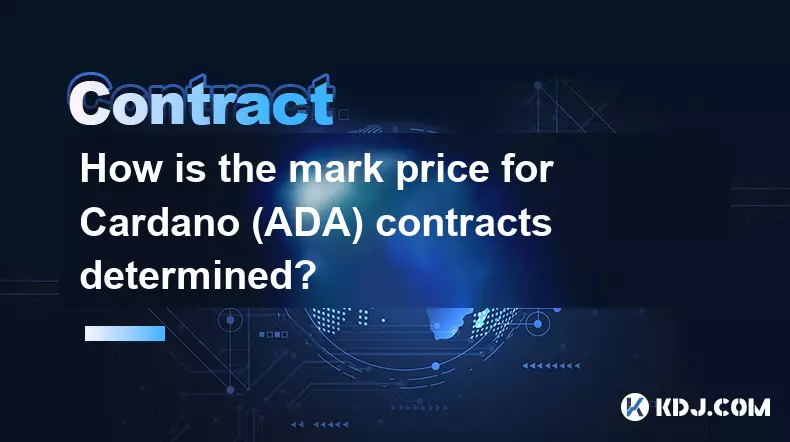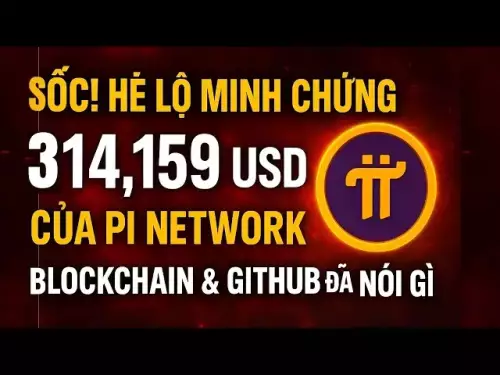-
 bitcoin
bitcoin $109547.008142 USD
0.04% -
 ethereum
ethereum $4011.838726 USD
-0.05% -
 tether
tether $1.000402 USD
-0.01% -
 xrp
xrp $2.798606 USD
0.88% -
 bnb
bnb $970.877944 USD
1.39% -
 solana
solana $202.237275 USD
-0.95% -
 usd-coin
usd-coin $0.999673 USD
0.00% -
 dogecoin
dogecoin $0.229294 USD
-1.15% -
 tron
tron $0.336370 USD
-0.45% -
 cardano
cardano $0.777260 USD
-1.66% -
 hyperliquid
hyperliquid $45.503019 USD
1.73% -
 ethena-usde
ethena-usde $1.000362 USD
0.01% -
 chainlink
chainlink $20.785303 USD
-1.10% -
 avalanche
avalanche $28.755822 USD
-0.11% -
 stellar
stellar $0.358303 USD
-0.48%
How is the mark price for Cardano (ADA) contracts determined?
The ADA futures mark price uses spot data, TWAP, and funding rates from major exchanges to ensure fair, stable pricing and prevent manipulation during volatility.
Sep 27, 2025 at 06:36 pm

Understanding the Mark Price Mechanism for Cardano (ADA) Futures
The mark price for Cardano (ADA) futures contracts plays a crucial role in maintaining fairness and preventing manipulation during volatile market conditions. It is not simply the last traded price on an exchange but a calculated value derived from multiple data sources to reflect a more accurate and stable representation of ADA’s true market value.
Components Influencing the ADA Mark Price
- 1. The primary input for determining the mark price is the spot price of Cardano (ADA) sourced from major cryptocurrency exchanges. These exchanges typically include Binance, Coinbase, Kraken, and others known for high liquidity and reliable pricing data. Aggregating prices across these platforms reduces the risk of anomalies or flash crashes affecting the valuation.
- 2. A time-weighted average price (TWAP) is often applied to the spot data to smooth out short-term volatility. This method calculates the average price over a defined period—usually five to thirty minutes—ensuring that sudden spikes or dips do not distort the mark price.
- 3. Funding rates are factored into the mark price calculation on perpetual contracts. Since perpetual swaps do not have an expiration date, funding mechanisms align the contract price with the underlying spot value. The mark price incorporates this adjustment to prevent unfair liquidations when the contract trades at a premium or discount to the spot market.
- 4. Oracles or external price feeds may be used by certain decentralized derivatives platforms to pull ADA price data. These systems rely on trusted nodes or blockchain-based aggregation protocols to deliver tamper-resistant pricing information directly to smart contracts.
- 5. Exchange-specific methodologies vary slightly, but most use a composite index combining spot prices from several exchanges. If one exchange reports an outlier due to low volume or technical issues, its influence is minimized through weighting algorithms that prioritize platforms with stronger trading activity.
Role of the Mark Price in Risk Management
- 1. The mark price is essential for calculating unrealized profit and loss (PnL) for open positions. Traders can assess their portfolio performance based on a realistic valuation rather than potentially manipulated last-traded prices.
- 2. Liquidation engines use the mark price to determine when leveraged positions should be closed. Using the last traded price could allow bad actors to trigger liquidations through spoofing or wash trading; the mark price mitigates this risk by relying on broader market consensus.
- 3. During periods of extreme volatility, such as network congestion or macroeconomic shocks, the mark price acts as a stabilizing force. It prevents cascading liquidations that might otherwise occur if pricing were based solely on erratic order book activity.
- 4. Exchanges apply a buffer between the mark price and the bankruptcy price to protect both traders and the platform's insurance fund. This ensures that even in fast-moving markets, liquidations occur only when justified by genuine market movements.
- 5. Transparent disclosure of the mark price formula allows traders to anticipate how their positions will be treated under different scenarios. Platforms often publish documentation detailing which exchanges are included, how frequently data is updated, and how outliers are filtered.
Impact of Market Structure on ADA Pricing Accuracy
- 1. High trading volume across diverse exchanges enhances the reliability of the spot index used in mark price calculations. Cardano’s presence on top-tier platforms ensures sufficient data depth for accurate aggregation.
- 2. Arbitrage activity between spot and futures markets helps keep the mark price closely aligned with real-world value. Traders exploit discrepancies, effectively correcting mispricings before they affect contract settlements.
- 3. Regulatory developments influencing major exchanges can indirectly impact the quality of price feeds. Restrictions or shutdowns in key jurisdictions may reduce the number of valid sources, increasing reliance on fewer data points.
- 4. Decentralized finance (DeFi) platforms integrating ADA derivatives must design robust oracle solutions. Poorly secured or centralized oracles introduce vulnerabilities that could compromise the integrity of the mark price.
- 5. Network upgrades or hard forks in the Cardano ecosystem may temporarily affect token availability on exchanges. During such events, some platforms pause futures trading or adjust their pricing models to account for potential supply disruptions.
Frequently Asked Questions
What happens to the ADA mark price during a network outage on a major exchange?When a major exchange experiences downtime, its price feed is typically excluded from the index until normal operations resume. The remaining exchanges continue to contribute data, and statistical filters prevent stale or missing values from skewing the overall calculation.
Can the mark price differ significantly from the current futures price?Yes, temporary deviations can occur due to funding rate adjustments or shifts in sentiment. However, persistent gaps usually attract arbitrageurs who act to bring the two prices back into alignment through buying or selling pressure.
Do all exchanges calculate the ADA mark price the same way?No, each exchange implements its own variation of the mark price model. While most rely on spot indices and TWAPs, the selection of exchanges, weighting methods, and update frequencies can differ, leading to minor variations in reported values.
Why isn't the last traded price sufficient for liquidations?The last traded price can be easily manipulated through spoofing or large market orders. Relying on it alone would expose traders to artificial liquidations. The mark price provides a more resilient benchmark by incorporating broader market data and smoothing techniques.
Disclaimer:info@kdj.com
The information provided is not trading advice. kdj.com does not assume any responsibility for any investments made based on the information provided in this article. Cryptocurrencies are highly volatile and it is highly recommended that you invest with caution after thorough research!
If you believe that the content used on this website infringes your copyright, please contact us immediately (info@kdj.com) and we will delete it promptly.
- BONK Investment: From $1K to $96K Gains and the Hunt for the Next Big Meme Coin
- 2025-09-28 16:25:12
- zkVerify's VFY Token Lands on KuCoin: A New Era for Zero-Knowledge Proofs?
- 2025-09-28 16:45:14
- Cathie Wood, Hyperliquid, and Solana: Decoding the Future of Crypto
- 2025-09-28 16:45:14
- Pi Wallet: Guardian of Meritocracy and GCV Stability in the Pi Network
- 2025-09-28 16:25:12
- Crypto Bulls Target QNT Token: Will the Rally Last?
- 2025-09-28 16:50:01
- Quant's Rally: Bulls Eye $103 Liquidity Amidst Market Optimism
- 2025-09-28 16:30:01
Related knowledge

How do I enable the "scalping-only" mode for Cardano (ADA) contracts?
Sep 24,2025 at 03:19am
Understanding Scalping Strategies in Crypto Derivatives1. Scalping in cryptocurrency trading refers to executing multiple short-term trades within min...

What is the settlement time for Cardano (ADA) contracts?
Sep 28,2025 at 04:18am
Understanding Cardano's Contract Settlement Mechanism1. Cardano operates on a proof-of-stake consensus model known as Ouroboros, which fundamentally i...

How do I add margin to Cardano (ADA) contracts?
Sep 27,2025 at 07:54pm
Understanding Margin in Cardano (ADA) Smart ContractsCardano operates on a proof-of-stake blockchain that supports smart contracts through its Plutus ...

What is the maximum position limit for Cardano (ADA) contracts?
Sep 23,2025 at 11:00pm
Understanding ADA Futures and Derivatives Market Structure1. Cardano (ADA) futures contracts are offered by several major cryptocurrency derivatives e...

What is the maker fee for Cardano (ADA) contracts?
Sep 26,2025 at 09:01am
Understanding Maker Fees in Cardano (ADA) Contracts1. The concept of maker fees applies broadly across decentralized exchanges and smart contract plat...

How can I view open interest in Cardano (ADA) contracts?
Sep 24,2025 at 07:36am
Understanding Open Interest in Cardano Derivatives1. Open interest refers to the total number of outstanding derivative contracts, such as futures or ...

How do I enable the "scalping-only" mode for Cardano (ADA) contracts?
Sep 24,2025 at 03:19am
Understanding Scalping Strategies in Crypto Derivatives1. Scalping in cryptocurrency trading refers to executing multiple short-term trades within min...

What is the settlement time for Cardano (ADA) contracts?
Sep 28,2025 at 04:18am
Understanding Cardano's Contract Settlement Mechanism1. Cardano operates on a proof-of-stake consensus model known as Ouroboros, which fundamentally i...

How do I add margin to Cardano (ADA) contracts?
Sep 27,2025 at 07:54pm
Understanding Margin in Cardano (ADA) Smart ContractsCardano operates on a proof-of-stake blockchain that supports smart contracts through its Plutus ...

What is the maximum position limit for Cardano (ADA) contracts?
Sep 23,2025 at 11:00pm
Understanding ADA Futures and Derivatives Market Structure1. Cardano (ADA) futures contracts are offered by several major cryptocurrency derivatives e...

What is the maker fee for Cardano (ADA) contracts?
Sep 26,2025 at 09:01am
Understanding Maker Fees in Cardano (ADA) Contracts1. The concept of maker fees applies broadly across decentralized exchanges and smart contract plat...

How can I view open interest in Cardano (ADA) contracts?
Sep 24,2025 at 07:36am
Understanding Open Interest in Cardano Derivatives1. Open interest refers to the total number of outstanding derivative contracts, such as futures or ...
See all articles










































































